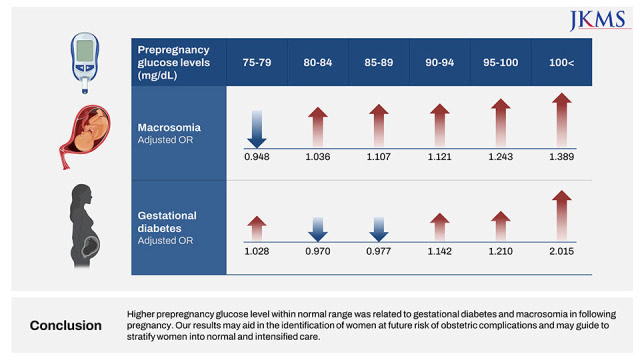1. HAPO Study Cooperative Research Group;. Metzger BE, Lowe LP, Dyer AR, Trimble ER, Chaovarindr U, et al. Hyperglycemia and adverse pregnancy outcomes. N Engl J Med. 2008; 358(19):1991–2002. PMID:
18463375.

2. Kim M. Prediction and prevention of large for gestational age in gestational diabetes mellitus. Korean J Perinatol. 2016; 27(1):8–14.
3. Harder T, Rodekamp E, Schellong K, Dudenhausen JW, Plagemann A. Birth weight and subsequent risk of type 2 diabetes: a meta-analysis. Am J Epidemiol. 2007; 165(8):849–857. PMID:
17215379.
4. Riskin-Mashiah S, Damti A, Younes G, Auslender R. First trimester fasting hyperglycemia as a predictor for the development of gestational diabetes mellitus. Eur J Obstet Gynecol Reprod Biol. 2010; 152(2):163–167. PMID:
20579799.
5. Lee KH, Han YJ, Chung JH, Kim MY, Ryu HM, Kim JH, et al. Treatment of gestational diabetes diagnosed by the IADPSG criteria decreases excessive fetal growth. Obstet Gynecol Sci. 2020; 63(1):19–26. PMID:
31970124.
6. Hao M, Lin L. Fasting plasma glucose and body mass index during the first trimester of pregnancy as predictors of gestational diabetes mellitus in a Chinese population. Endocr J. 2017; 64(5):561–569. PMID:
28420856.
7. Sesmilo G, Prats P, Garcia S, Rodríguez I, Rodríguez-Melcón A, Berges I, et al. First-trimester fasting glycemia as a predictor of gestational diabetes (GDM) and adverse pregnancy outcomes. Acta Diabetol. 2020; 57(6):697–703. PMID:
31984438.
8. Landon MB, Spong CY, Thom E, Carpenter MW, Ramin SM, Casey B, et al. A multicenter, randomized trial of treatment for mild gestational diabetes. N Engl J Med. 2009; 361(14):1339–1348. PMID:
19797280.
9. Oh T, Jang HC. Gestational diabetes mellitus: diagnosis and glycemic control. J Korean Diabetes. 2020; 21(2):69–74.

10. Salman L, Arbib N, Shmueli A, Krispin E, Wiznitzer A, Hadar E. The association between pre-pregnancy impaired fasting glucose and adverse perinatal outcome. Diabetes Res Clin Pract. 2018; 140:148–153. PMID:
29601914.

11. Hu CY, Li FL, Jiang W, Hua XG, Zhang XJ. Pre-pregnancy health status and risk of preterm birth: a large, Chinese, rural, population-based study. Med Sci Monit. 2018; 24:4718–4727. PMID:
29982265.

12. Tang J, Zhu X, Li M, Huang D, Zhao Q. The impact of maternal prepregnancy impaired fasting glucose on preterm birth and large for gestational age: a large population-based cohort study. Am J Obstet Gynecol. 2020; 222(3):265.e1–265.19.

13. Lee SH, Yu J, Han K, Lee SW, You SY, Kim HS, et al. Predicting the risk of insulin-requiring gestational diabetes before pregnancy: a model generated from a nationwide population-based cohort study in Korea. Endocrinol Metab (Seoul). 2023; 38(1):129–138. PMID:
36702473.

14. Innes KE, Byers TE, Marshall JA, Barón A, Orleans M, Hamman RF. Association of a woman’s own birth weight with subsequent risk for gestational diabetes. JAMA. 2002; 287(19):2534–2541. PMID:
12020334.

15. Turner N, Robker RL. Developmental programming of obesity and insulin resistance: does mitochondrial dysfunction in oocytes play a role? Mol Hum Reprod. 2015; 21(1):23–30. PMID:
24923276.

16. Brown J, Alwan NA, West J, Brown S, McKinlay CJ, Farrar D, et al. Lifestyle interventions for the treatment of women with gestational diabetes. Cochrane Database Syst Rev. 2017; 5(5):CD011970. PMID:
28472859.

17. Song C, Li J, Leng J, Ma RC, Yang X. Lifestyle intervention can reduce the risk of gestational diabetes: a meta-analysis of randomized controlled trials. Obes Rev. 2016; 17(10):960–969. PMID:
27417680.

18. Ko JM, Lee JK. Effects of a coaching program on comprehensive lifestyle modification for women with gestational diabetes mellitus. J Korean Acad Nurs. 2014; 44(6):672–681. PMID:
25608545.







 PDF
PDF Citation
Citation Print
Print




 XML Download
XML Download